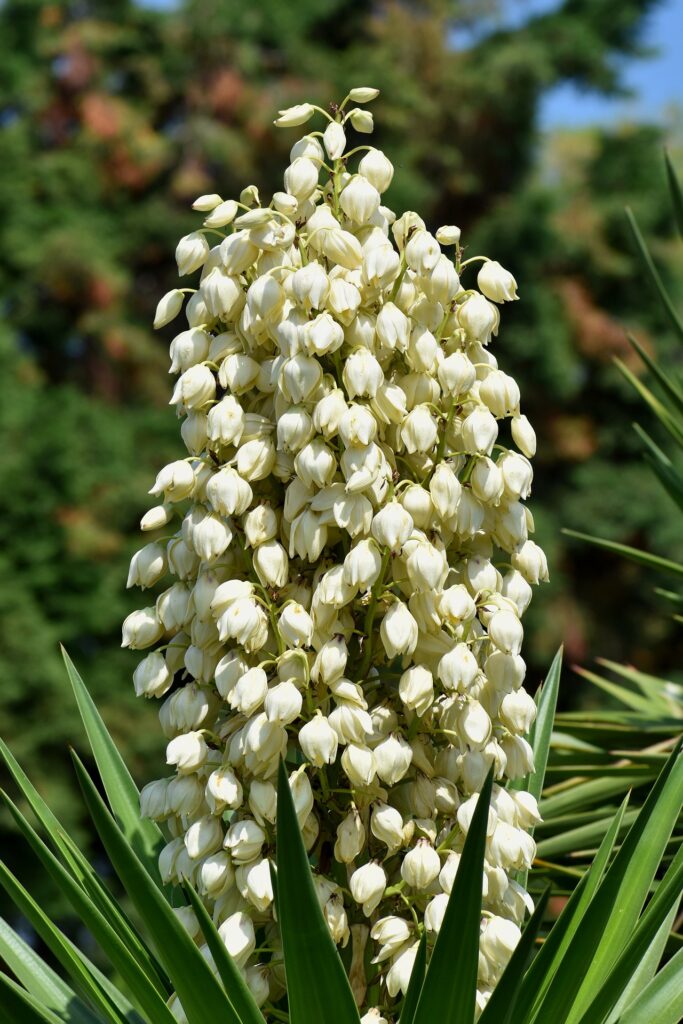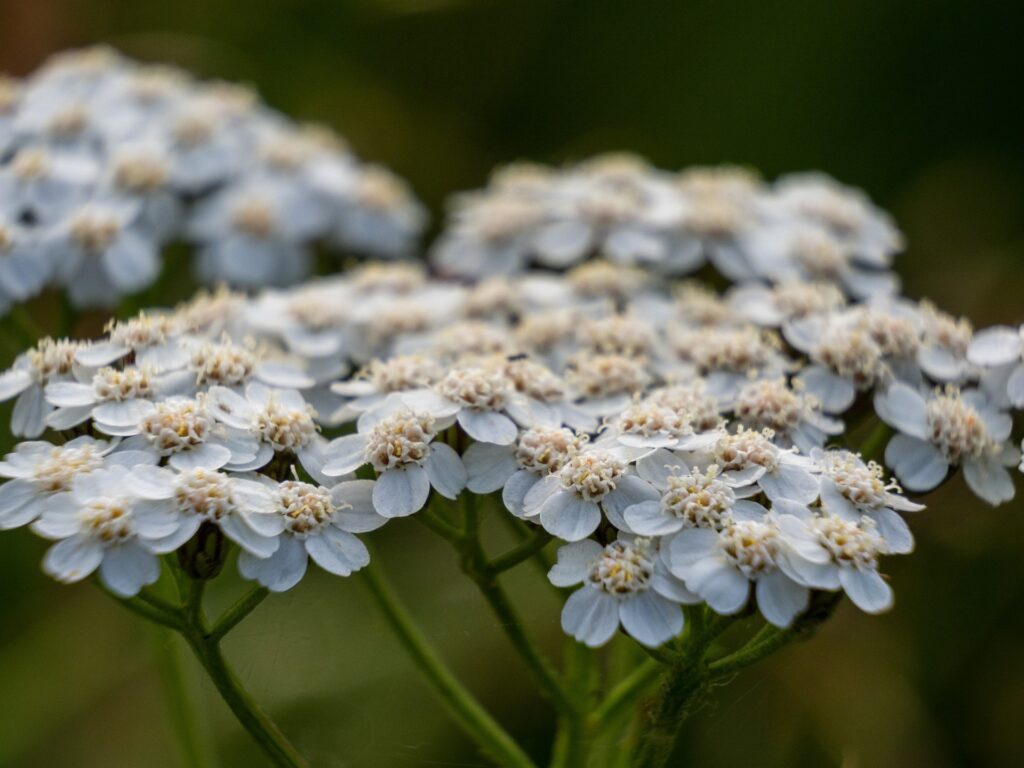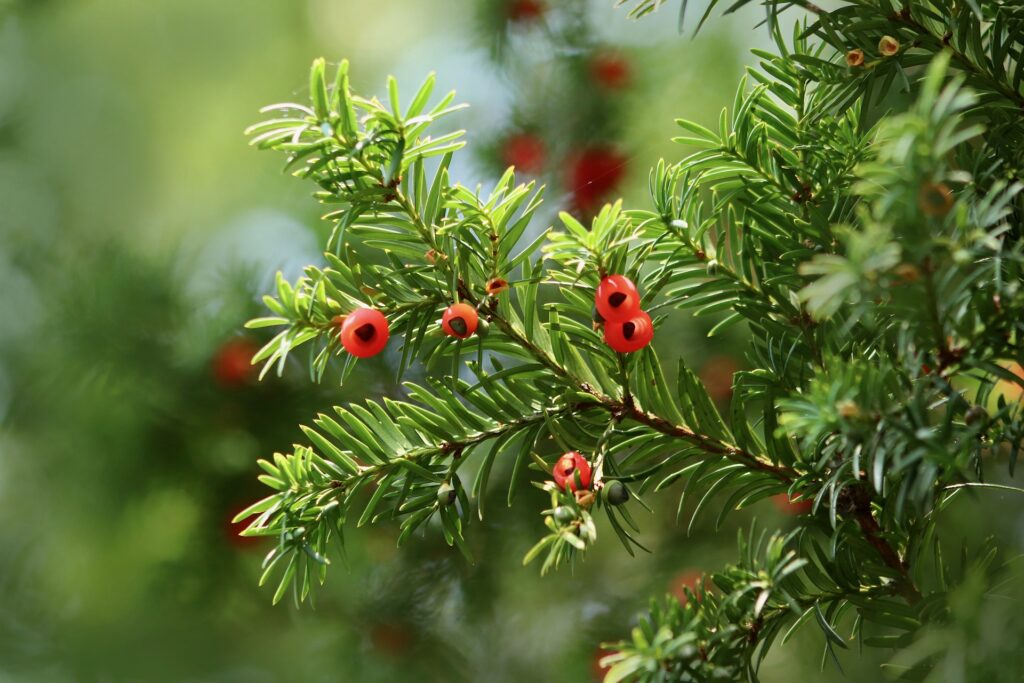Flowers that start with Y are few and far between, there are actually only two plants that are currently recognised in modern botany as starting with the letter Y.
However, synonymous names are regularly used within the Horticulture world, so we thought we would deep dive into the world of Y, rather than just scraping the surface. Whether you want to find some new plants, or learn about synonymous names – Read on to learn more!
1. Yucca

The Yucca genus is the only flowering plant recognised in modern botany as begging with the letter Y. This flowering perennial plant is native to the Americas and the Caribbean, so you just might have seen it when on a hike – they generally love hot and arid climates, so have become naturalised in other parts of the world that exhibit this climate. Yucca is a genus of shrub that is part of the Asparagaceae family.
That’s right, the Yucca is a closer relative of Asparagus, which we all know but may not love. This isn’t too hard to believe when you see a mature Yucca plant and its glorious inflorescence; the Yucca’s inflorescence is very similar to the head of the Asparagus plant. Large panicles emerge from the long sabre-like foliage – one panicle can contain a load of flowers.
Most commonly, the flowers are usually some shade of white or cream spending of the species of which there are 49 as well as 24 subspecies.
While Yucca is a shrub, they can grow into trees up to 12 metres tall. Flowers often sprout during mid maturity but when the shrub becomes a tree they tend to stop flowering. The Yucca tree is pretty easy to spot, it has a very woody body but the plant retains its frond-like leaves during maturity and they sprout on the ends of the branches.
Surprisingly, although perhaps not if we remember this plant is related to the asparagus, many of the flowers of the Yucca plant are edible. While the plant is cultivated for its ornamental qualities, seeds , flowers and parts of the leaves are edible, not to mention the purple Yucca fruit.
Historically used by Native American tribes, the fruit can be edible when roasted and this process makes it really sweet, many modern culinary uses are for pie fillings.
If you are interested in why the plant begins with Y, Carl Linnaeus, the father of modern taxonomy, found that many people mistook the Yucca for the Cassava genus (Manihot esculenta). Thus, he used the local Taíno word for the latter, yuca.
Related: 9 Unusual Flowers That Start With X (With Pictures)
2. Yushania

While not a flowering plant, but in fact a genus of bamboo, it’s still worth mentioning the Yushania plant as it is only one of two, alongside Yucca, that are recognised in modern botany as starting with the letter Yushania is genus of bamboo that is in the grass family Poaceae, and the subfamily of bamboo, Bambusoidea.
This genus produces evergreen but thornless bamboo that spreads widely. This is commonly found in the Himalayan, African and Asian mountains as it enjoys high altitudes of up to 3000m. Where this bambo genus differs from others is principally in having rhizomes that allow them to spread widely into dense bamboo forests.
Due to the spreading ability of this bamboo, they are considered an invasive species or weed, technically.
Sadly, there isn’t a great use for the bamboo, beyond its natural place as food etc. However, in spite of this many gardeners use bamboo as ‘fencing’ or ‘screening’ in suburban environments as the dense clusters of bamboo can help create privacy within a suburban garden.
However, we should take some caution when planting Yushania as it is such a wide spreader. In warmer climates especially, it could spread like wildfire and be pretty invasive.
Why the Y? The Yushania plant is named after the highest mountain in Taiwan, Yu Shan or Jade Mountain.
3. Yarrow (Achillea)

The genus Achillea is commonly referred to as ‘Yarrow’, this usually specifically refers to the species Achillea millefolium – Yarrow is an english name rooted in the languages historical Saxonic influences.
However, the name Achillea refers to the Greek god Achilles who carried the plant with him in battle to treat his troops’ wounds. In classical Greek literature, Homer tells the story of Chiron and how he taught his pupils, including Achilles, to use yarrow on the battleground of Troy.
Back to the botany, the Achillea is an erect herbaceous perennial plant. It is part of the family Asteraceae. The Yarrow was first described as genus by our old friend Carl Linnaeus, proving he really is the father of modern taxonomy. Its flowers come from its several stems that have a spreading rhizomatous growth.
The inflorescence is produced in clusters onto the several stems and is a popular pollination station for a large number of insects. The flowers can vary in color greatly but consistently have a pleasant sweet smell that some might compare to a chrysanthemum.
The plant is principally endemic to Europe and is commonly seen across the United Kingdom, but can also be found in temperate parts of Asia and North America where many of its vast species occur. Many insects seriously love the Achillea due to its scent and also its aromatic hairy leaves.
A huge amount of larvae and moth species feed specifically on the yarrow making it of great interest to entomologists.
There are SO many different varieties of Achillea, potentially over 1000, but there’s a wide debate among botanists and horticulturists alike about which species should be subspecies, which should even be recognised as an independent species and much more.
However, many Achellia species have won the Royal Horticultural Society (RHS) coveted AGM or award of garden merit. So, understandably, the yarrow is cultivated widely for its looks, scent, and high status among gardeners.
Related: 31 Wonderful Flowers That Start With W (Including Pictures)
4. Yew tree (Taxus)

If you have ever been to europe we can guarantee that you will have seen a yew tree, the common name in Europe for what is known by latin nomenclature as Taxus. While the tree is common in Europe it can basically grow anywhere. It is a large tree that is very slow growing and thus can become extremely mature in age.
The oldest fossil dates back to the Early Cretaceous period so it’s for sure one of the oldest trees still around. In the quaint churchyard of St Cynog in Swansea, there is a 60 foot wide Yew tree that is proven to be over 5000 years old, making it older than the Egyptian pyramids, and it still stands to this day.
While there are quite a few recognised species of Taxus, they are all very closely related. Thus, there is a great amount of botanical and horticultural debate about whether all of the Taxus are subsumed under the original species Taxus baccata, or the European Yew. However, many sources recognise around 9 species, although this may differ.
For all of the glory of the Yew tree there is a level of toxicity that should be made aware. All species of yew contain a specific alkaloid to Taxus species called taxine that is poisonous. While humans and some deer have the ability to break down the alkaloid through their stomach, many other animals cannot.
While yew trees have been described as ‘death defying’, they have killed many animals, and oftentimes animals can be found dead at the foot of the yew tree having eaten its leaves. For this reason many farmers uproot and destroy the Yew trees that surround their farmland to save their animals.
These alkaloids, while broken down by the stomach in small doses, can be deadly to humans when consumed in large amounts.
Moreover, yew trees also have pollen that can be described as cytotoxic. Even those who don’t have hay fever or other allergies can still get headaches, fatigue, aching joints, itching and many more undesirable symptoms from coming into contact with this pollen. If you do have hay fever then these symptoms can get worse while not commonly fatal.
Specifically, male yew trees in bloom should be avoided for their extreme excretion of pollen. This pollen is very visible when you touch the yew tree and is small enough to pass through screens and travel through windows, just see this video for reference.
Rather interestingly, female yew trees do the exact opposite, they trap pollen and can be described as allergy fighting, adding only more mystery to the mythology of the ancient Yew tree.
The Final Word
So, even though the letter Y is so sparingly used within plant nomenclature, there are many plants that you will likely recognise that do start with the letter Y. While some are common names rather than the latin nomenclature botanists refer to, they can be used interchangeably.
This goes to show that grouping plants by their initial letter is a good way to learn names and explore the plant world systematically, but isn’t the ideal method for grouping and categorising plants.
We hope you learned something from this article, here are other articles that you can learn from:
12 Fantastic Brandy Flowers (Including Pictures)







